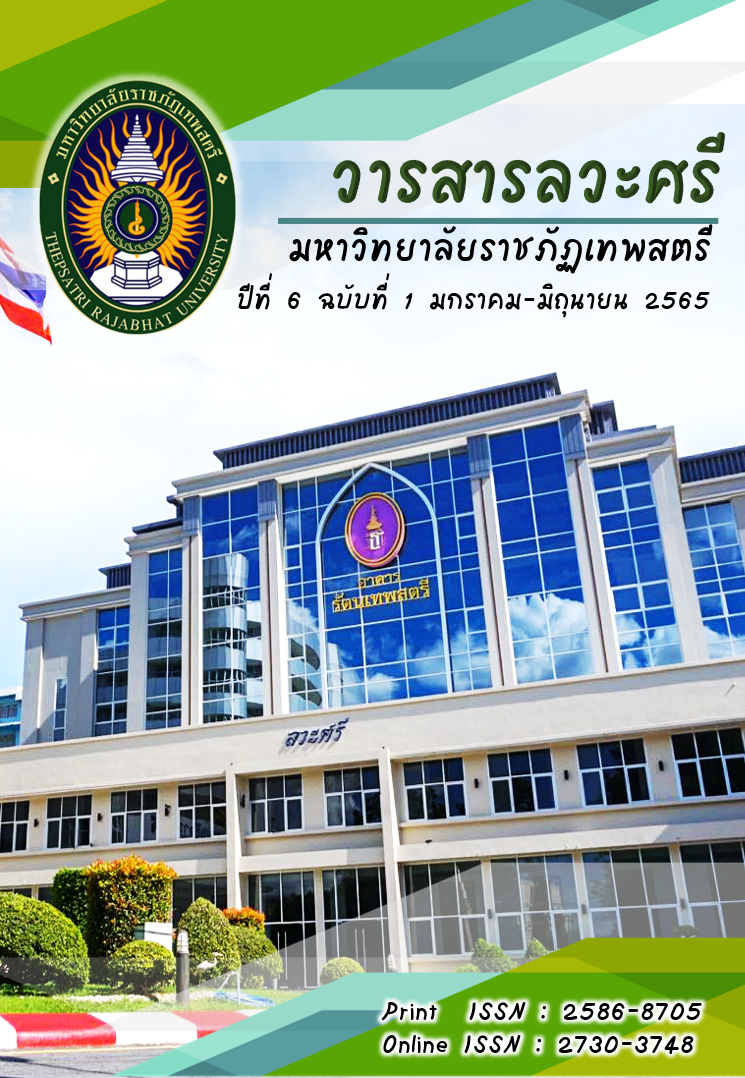การตลาดเชิงสัมพันธ์ การรับรู้คุณภาพบริการและความพึงพอใจที่มีอิทธิพลต่อ ความภักดีของลูกค้าที่ใช้บริการจากผู้แทนขายอุปกรณ์ทดแทนหรือ อุปกรณ์เสริมเพื่อการรักษาในประเทศไทย
คำสำคัญ:
การตลาดเชิงสัมพันธ์, การรับรู้คุณภาพบริการ, ความพึงพอใจ, ความภักดี, ผู้แทนขาย, อุปกรณ์ทดแทนหรืออุปกรณ์เสริมเพื่อการรักษาบทคัดย่อ
การวิจัยมีวัตถุประสงค์เพื่อศึกษาความสำคัญการตลาดเชิงสัมพันธ์ การรับรู้คุณภาพบริการ ความพึงพอใจและความภักดีของลูกค้าและวิเคราะห์การตลาดเชิงสัมพันธ์ การรับรู้คุณภาพบริการและความพึงพอใจที่มีอิทธิพลต่อความภักดีของลูกค้าที่ใช้บริการจากผู้แทนขายอุปกรณ์ทดแทนหรืออุปกรณ์เสริมเพื่อการรักษาในประเทศไทย กลุ่มตัวอย่าง คือ แพทย์และพยาบาลโรงพยาบาลภาครัฐและเอกชนที่ซื้ออุปกรณ์ทดแทนหรืออุปกรณ์เสริมเพื่อการรักษา จำนวน 454 คน เครื่องมือ คือ แบบสอบถาม วิเคราะห์ข้อมูล โดยสถิติพรรณนาหาค่าความถี่ ค่าร้อยละ และ ค่าส่วนเบี่ยงเบนมาตรฐาน สถิติอนุมานหาความสัมพันธ์ของสมการโครงสร้าง ด้วยโปรแกรม ADANCO
ผลวิจัยพบว่า ทุกปัจจัยสำคัญระดับมากตามลำดับ คือ การรับรู้คุณภาพบริการ ความพึงพอใจ การตลาดเชิงสัมพันธ์และความภักดีของลูกค้า ผลการวิเคราะห์การตลาดเชิงสัมพันธ์ คุณภาพบริการและความพึงพอใจที่มีอิทธิพลต่อความภักดีของลูกค้า พบว่าการตลาดเชิงสัมพันธ์มีอิทธิพลต่อการรับรู้คุณภาพบริการมากที่สุด รองลงมา คือ การรับรู้คุณภาพบริการมีอิทธิพลต่อความพึงพอใจ ความพึงพอใจมีอิทธิพลต่อความภักดีของลูกค้า การตลาด เชิงสัมพันธ์มีอิทธิพลต่อความพึงพอใจ ลำดับสุดท้ายการตลาดเชิงสัมพันธ์มีอิทธิพลต่อความภักดีของลูกค้า ผลวิจัยเป็นประโยชน์ในการส่งเสริมธุรกิจบริการซึ่งมีบทบาทสำคัญในการสนับสนุนระบบเศรษฐกิจเชิงสุขภาพ เพื่อให้ผู้เกี่ยวข้องนำไปใช้ในการศึกษาและต่อยอดงานวิจัยต่อไป
เอกสารอ้างอิง
กองบริหารการสาธารณสุข กระทรวงสาธารณสุข, (2564). ข้อมูลโรงพยาบาลสังกัดกระทรวงสาธารณสุข. สืบค้น กรกฎาคม 27, 2564, จาก http://cmi.moph.go.th/report/micro/index?menu_id=6
กรุงเทพมหานคร,(2564). ข้อมูลโรงพยาบาลสังกัดกรุงเทพมหานคร. สืบค้น สิงหาคม 1, 2564, จากhttp://data.bangkok.go.th/dataset/bmahospital/resource/eb548cdb-1a9a-4347-b85c719 0 25 46c91c
จักรพันธ์ กิตตินรรัตน์ และอรณัฏฐ์ นครศรี. (2560). ปัจจัยที่ส่งผลต่อความภักดีของลูกค้าต่อโรงพยาบาลเอกชนในเขตกรุงเทพมหานคร. วารสารเศรษฐศาสตร์และกลยุทธ์การจัดการ, 4(2), 43-58.
เหมราช สุขพันธ์. (2564). วันที่ 17 กรกฎาคม 2564 แพทย์เฉพาะทางด้านศัลยกรรมกระดูกและข้อโรงพยาบาลลำปาง, สัมภาษณ์.
นงคราญ ไชยเมือง เซ่าหยี แซ่ฟัง และสุตาภัทร คงเกิด. (2020). การตลาดเชิงสัมพันธ์เพื่อสร้างความภักดีของลูกค้าในยุคดิจิทัล, วารสารการจัดการและการพัฒนา มหาวิทยาลัยราชภัฏอุบลราชธานี, 7(1), 151-163.
นรเทพ กุลโชติ. (2564). ศัลยศาสตร์กระดูกและข้อ, การบาดเจ็บ,แผลบาดเจ็บ. สืบค้น สิงหาคม 1, 2564, จาก www.rama.mahidol.ac.th
นิศาชล รัตนมณี และประสพชัย พสุนนท์. (2562) อัตราการตอบกลับของแบบสอบถามในงานวิจัยเชิงปริมาณ.
Journal of Humanities and Social Sciences Thonburi University, 13(3), 181-188.
ราณี อมรินทร์รัตน์. (2560). ปัจจัยความสำเร็จของการตลาดเชิงสัมพันธ์ในอุตสาหกรรมท่องเที่ยว. วารสารวิจัยและพัฒนาวไลยอลงกรณ์ในพระบรมราชูปถัมภ์, 12(2), 321-329.
ศักดิ์ดา ศิริภัทรโสภณ และปารย์ทิพย์ ธนาภิคุปตานนท์. (2554). ความสัมพันธ์ระหว่างคุณภาพการบริการที่ได้รับ
กับความพึงพอใจและความภักดีของคนไข้ : กรณีศึกษาโรงพยาบาลเอกชนในเขตกรุงเทพมหานคร.KKU Research, Journal, 10(2), 160-172.
สำนักงานสภาพัฒนาเศรษฐกิจและสังคมแห่งชาติ. (2564). แผนพัฒนาเศรษฐกิจและสังคมแห่งชาติ ฉบับที่ 13,
สืบค้น กรกฎาคม 12, 2564, จาก https://www.google.com/search
สมาคมโรงพยาบาลเอกชน, (2564). สมาชิกสมาคมโรงพยาบาลเอกชน. สืบค้น สิงหาคม1, 2564, จากhttp://www.thaiprivatehospitals.org/marker-hospital
สฤษดิ์ ศรีโยธิน. (2562) การจัดการความคาดหวัง : เครื่องมือสร้างคุณภาพในองค์กรบริการ. วารสารร่มพฤกษ์
มหาวิทยาลัยเกริก, 37(1), 134-162.
Anderson, E.W. , & Sullivan, M.W. (1993) The antecedents and consequences of customer satisfaction for firms. Marketing Science, 12, 125-143.
Cavana, R., Delahaye, B., & Sekaran, U. (2001). Applied Business Research: Qualitative and
Quantitative Method. (3rd ed.). Australia: John Wiley & Sons.
Chiu-Han Wang & Sejin Ha (2011). Store attributes influencing relationship marketing: A study of department
stores. Journal of Fashion Marketing and Management, 15(3), 326-344.
Christopher, M., Payne, A., & Ballantyne, D. (1991). Relationship Marketing: Bringing Quality, Customer Service and Marketing Together. Oxford: Butterworth Heinemann.
Cronin, J. J., Brady, M. K., & Hult, G. T. M. (2000). Assessing the effects of quality, value, and customer satisfaction on consumer behavioral intentions in service environments. Journal of Retailing, 76 (2); 193-218.
Cronbach, L, J. (1974). Essentials of Psychological Testing. New York : Harper and Row.
Fornell, C., & Larcker, D. F. (1981). Evaluating structural equation models with unobservable variables and measurement error. Journal of Marketing Research, 18(1), 39–50.
Garbarino, E. & Johnson, M.S (1999) The different roles of satisfaction, trust, and commitment in
customer relationships. Journal of Marketing, 63(2), 78-86.
Gedefaw, M. , & Simeng, B. (2014). Assessment of prevalence and associated factors of adherence
to Antihypertensive agents among adults on follow up in Adama Referal Hospital, East
Shoa, Ethiopia-Cross sectional study. International Journal of Current Microbiology
and Applied Sciences, 3(2), 760-770.
Grönroos, C. (2007). Service Management and Marketing, (3rd ed.) England: John Wiley and Sons.
Gummesson, E. (2012). Marketing revisited: The crucial role of the part-time marketers. European Journal of Marketing, 25(2), 60-79.
Gummesson, E. (1997) Relationship marketing as a paradigm shift: some conclusions from the 30R approach. Management Decision, 35(4), 267-272.
Hair, J., Blak, W.C., Barbin, B.J., Anderson, R. E., & Tatham, R.L. (2010). Multivariate Data Analysis. New Jersey: Upper Sandle River, Prentice Hall.
Karyose, H. Astuti ,W. and Ferdiansjah, A. (2017) Customer loyalty: The effect of service quality, corporate image, customer relationship marketing and customer satisfaction as intervening variable-an empirical analysis of Bank customers in Malang City. Marketing and Branding Research, 4(4), 336-347.
Kelley, S. W., & Davis, M. A. (1994). Antecedents to customer expectations for service recovery. Journal of the Academy of Marketing Science, 22(1), 52–61.
Kim, W. G., & Cha, Y. (2002). Antecedents and consequences of relationship quality in hotel industry. International Journal of Hospitality Management. 21(4), 321-338.
Kotler, P. , & Amstrong, G. (2012). Principle of Marketing. (14 th ed.). New Jersey. Prentice HallLimo, K. P. , Kosgei. N. C. , Kiprop. N. K. , Nkobe. D. K. , & Kiplagat, K. T. (2014). Effects of relationship marketing on customer loyalty: Evidence from petrol service stations in
Uasin-Gishu County Kenya. European Journal of Business and Management, 6(25),2222-2839
Mohammad, H. A., J Khalafi, A. A. , Niko, M. A. , & Joyami, E. H. (2015). Investigating the effect of
the relationship marketing tactics on customer’s loyalty. Academic Journal of
Economic Studies, 1(1), 5–21.
Morgan, R. M., & Hunt, S. D. (1994). The commitment-trust theory of relationship marketing. Journal of Marketing, 58(1), 20-38.
Ninkitsaranont, P., & Sathapongppakdee, P. (2017). Thailand Industry Outlook 2017-2019: Modern Trade. Bangkok: Krungsri Research.
Oliver, R. L. (1980). A cognitive model of the antecedents and consequences of satisfaction decisions. Journal of Marketing Research, 17(4), 460-469.
Oliver, R. L. (1999). “Whence consumer loyalty?”, Journal of Marketing. 63(2); 33-44.
Parasuraman, A., Zeithaml, V., & Berry, L. L. (1988). SERVQUAL: A multiple-item scale for measuring consumer perceptions of service quality. Journal of Retailing, 64(3), 12-40.
Parasuraman A., Zeithaml, Valarie A., & Leonard L. (1985). A conceptual model of service quality and its implications for future research. Journal of Marketing, 49(4), 41-45
Parasuraman, A., Berry, L. L., & Zeithaml, V. A. (1991). Perceived Service Quality as a Customer-Based Performance Measure: An Empirical Examination of Organizational Barriers Using an Extended Service Quality Model. Human Resource Management. 30(2); 335-364.
Rehman, M. S., Khan, A. H., & Haque, M. (2012). A conceptual study on the relationship between
service quality towards customer satisfaction: Seroquel and Gronroos’s service quality
model perspective. Asian Social Science, 8(13), 201-210.
Robert, M. G., & Lars, L. (2010). Total Survey Error: Past, Present, and Future. American Association for Public Opinion Research, 74(5), 849–879.
Shelly, M. W. (1975). Responding to Social Change. Pennsylvania: Dowden Hutchison & Press.
Singh, J., & Sirdeshmukh, D., (2000) Agency and trust mechanisms in consumer satisfaction and
loyalty judgments. Journal of the Academy of Marketing Science. 28,(1),150-167.
Sin, L.Y.M., Tse A. B., & Yim F.H.K. (2005). “CRM: Conceptualization and scale development.”European Journal of Marketing, 39(11/12); 1264-1290.
Tabachnick, B. G., & Fidell, L. S. (2007). Using Multivariate Statistics. (5th ed.). New York: Allyn and Bacon.
Veloutsou, C., Saren, M., & Tzokas, N. (2002). Relationship marketing, What if European Journal of Marketing, 36(4), 433-449.
ดาวน์โหลด
เผยแพร่แล้ว
รูปแบบการอ้างอิง
ฉบับ
ประเภทบทความ
สัญญาอนุญาต
ลิขสิทธิ์ (c) 2022 วารสารลวะศรี

อนุญาตภายใต้เงื่อนไข Creative Commons Attribution-NonCommercial-NoDerivatives 4.0 International License.
บทความ ข้อมูล เนื้อหา รูปภาพ ที่ได้รับการตีพิมพ์ในวารสารลวะศรี มหาวิทยาลัยราชภัฏเทพสตรี ถือเป็นลิขสิทธิ์ของวารสารลวะศรี หากบุคคลหรือหน่วยงานใดต้องการนำทั้งหมดหรือส่วนหนึ่งส่วนใดไปเผยแพร่ต่าหรือกระทำการใดๆ จะต้องได้รับอนาญาตจากวารสารวิชาการ ฯ ก่อนเท่านั้น เนื้อหาและข้อมูลในบทความที่ตีพิมพ์ในวารสารลวะศรี มหาวิทยาลัยราชภัฏเทพสตรี ถือเป็นข้อคิดเห็นและความรับผิดชอบของผู้เขียนบทความโดยตรง ซึ่งกองบรรณาธิการวารสารไม่จำเป็นต้องเห็นด้วย หรือร่วมรับผิดชอบใดๆ



